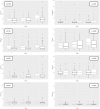Effectiveness of mid-regional pro-adrenomedullin, compared to other biomarkers (including lymphocyte subpopulations and immunoglobulins), as a prognostic biomarker in COVID-19 critically ill patients: New evidence from a 15-month observational prospective study
- PMID: 37035317
- PMCID: PMC10080079
- DOI: 10.3389/fmed.2023.1122367
Effectiveness of mid-regional pro-adrenomedullin, compared to other biomarkers (including lymphocyte subpopulations and immunoglobulins), as a prognostic biomarker in COVID-19 critically ill patients: New evidence from a 15-month observational prospective study
Abstract
Background: Mid-regional pro-adrenomedullin (MR-proADM), an endothelium-related peptide, is a predictor of death and multi-organ failure in respiratory infections and sepsis and seems to be effective in identifying COVID-19 severe forms. The study aims to evaluate the effectiveness of MR-proADM in comparison to routine inflammatory biomarkers, lymphocyte subpopulations, and immunoglobulin (Ig) at an intensive care unit (ICU) admission and over time in predicting mortality in patients with severe COVID-19.
Methods: All adult patients with COVID-19 pneumonia admitted between March 2020 and June 2021 in the ICUs of a university hospital in Italy were enrolled. MR-proADM, lymphocyte subpopulations, Ig, and routine laboratory tests were measured within 48 h and on days 3 and 7. The log-rank test was used to compare survival curves with MR-proADM cutoff value of >1.5 nmol/L. Predictive ability was compared using the area under the curve (AUC) and 95% confidence interval (CI) of different receiver-operating characteristic curves.
Results: A total of 209 patients, with high clinical severity [SOFA 7, IQR 4-9; SAPS II 52, IQR 41-59; median viral pneumonia mortality score (MuLBSTA)-11, IQR 9-13] were enrolled. ICU and overall mortality were 55.5 and 60.8%, respectively. Procalcitonin, lactate dehydrogenase, D-dimer, the N-terminal prohormone of brain natriuretic peptide, myoglobin, troponin, neutrophil count, lymphocyte count, and natural killer lymphocyte count were significantly different between survivors and non-survivors, while lymphocyte subpopulations and Ig were not different in the two groups. MR-proADM was significantly higher in non-survivors (1.17 ± 0.73 vs. 2.31 ± 2.63, p < 0.0001). A value of >1.5 nmol/L was an independent risk factor for mortality at day 28 [odds ratio of 1.9 (95% CI: 1.220-3.060)] after adjusting for age, lactate at admission, SOFA, MuLBSTA, superinfections, cardiovascular disease, and respiratory disease. On days 3 and 7 of the ICU stay, the MR-proADM trend evaluated within 48 h of admission maintained a correlation with mortality (p < 0.0001). Compared to all other biomarkers considered, the MR-proADM value within 48 h had the best accuracy in predicting mortality at day 28 [AUC = 0.695 (95% CI: 0.624-0.759)].
Conclusion: MR-proADM seems to be the best biomarker for the stratification of mortality risk in critically ill patients with COVID-19. The Ig levels and lymphocyte subpopulations (except for natural killers) seem not to be correlated with mortality. Larger, multicentric studies are needed to confirm these findings.
Keywords: COVID-19; MR-proADM; SARS-CoV-2; adrenomedullin; biomarkers; immunoglobulins; intensive care; lymphocyte subpopulations.
Copyright © 2023 Montrucchio, Sales, Balzani, Lombardo, Giaccone, Cantù, D'Antonio, Rumbolo, Corcione, Simonetti, Bonetto, Zanierato, Fanelli, Filippini, Mengozzi and Brazzi.
Conflict of interest statement
The authors declare that the research was conducted in the absence of any commercial or financial relationships that could be construed as a potential conflict of interest.
Figures





References
LinkOut - more resources
Full Text Sources
Other Literature Sources
Miscellaneous

